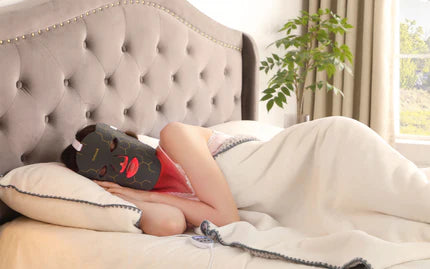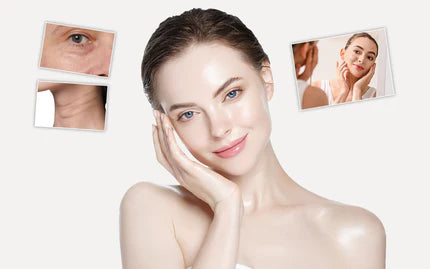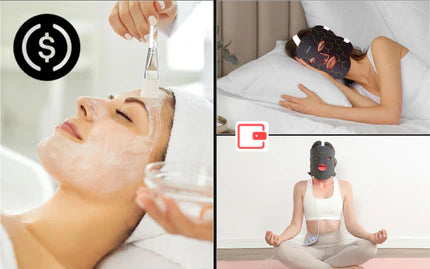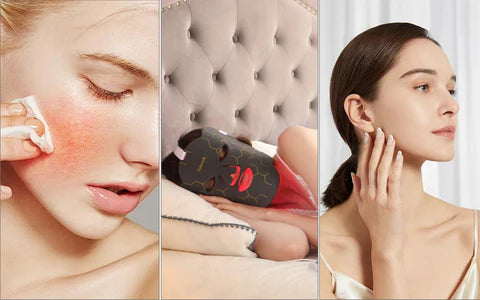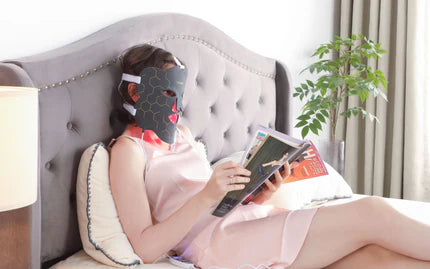Red light therapy (RLT) has sparked a lot of interest and debate, with many people wondering if it's just a passing trend or something with real benefits. This guide aims to clear up the confusion by debunking some of the most widespread myths about RLT and confirming its proven advantages.
We'll explain what red light therapy is, why it’s becoming more popular, and how safe it really is. Also, we'll broaden your understanding of how it can help not only with skin conditions but other health aspects as well. Plus, we'll take a look at how affordable it can be and set realistic expectations for how quickly it works.
With insights from scientific research and an overview of RLT's role in non-invasive medical treatments, this article will help you get to know the ins and outs of red light therapy in a straightforward way.
Myth 1: Red Light Therapy is Just a Fad
Some people may think red light therapy (RLT) is a temporary health trend that will disappear soon, just like other health fads have in the past. But RLT is different because its popularity is based on scientific research and positive results from many people who report better health after using it. Today, it's widely adopted by various users, from professional athletes looking to accelerate injury recovery to dermatologists treating skin conditions, as well as individuals at home seeking pain relief. Its enduring popularity is largely due to its effectiveness in reducing inflammation, aiding muscle recovery post-workout, and promoting healthier skin—benefits that are increasingly validated by scientific research.
What makes RLT particularly appealing is its user-friendly nature. Devices range from large, clinic-based machines to compact, at-home units, making it accessible to a broad audience. Its ease of use, coupled with tangible results, has solidified RLT as a credible treatment option rather than a passing fad. Because of these broad benefits, RLT is set to stay important in health care for a long time. It's more than just a passing trend; it's a helpful tool that will likely keep being used well into the future.
Myth 2: Red Light Therapy is Unsafe
Safety is a big concern when trying out any new health treatment. Some people worry that red light therapy (RLT) could be harmful, like getting too much sun can be harmful. However, RLT is safe when you follow the right instructions.
The red or near-infrared light used in RLT isn't like the sun's ultraviolet (UV) rays, which can hurt your skin and cause cancer. RLT uses safer light that can help cells make energy and heal.
Health professionals use red light therapy (RLT) carefully by following rules on where to place the device and how long to use it. The devices often have timers so that each session lasts just the right amount of time. If you're using RLT at home, you'll get instructions with your device — make sure to read and follow them closely. Also, while RLT is safe for your skin, the light can be very bright, so wearing protective glasses is a good idea. Finally, it's a good plan to check in with a doctor before starting RLT, especially if you have any medical conditions.
RLT is considered a safe option for treating pain and skin conditions, as long as you use it the way it's supposed to be used. It's not invasive and doesn't have severe side effects, making it an attractive choice for many people.

Myth 3: Red Light Therapy is Only for Skin Issues
Opposite to the general view, RLT is not applied only to skin problems. Though it is good to diminish wrinkles and clean up acne, its benefits go way beyond skin care. It helps in wound healing and reduces inflammation; hence, it will be of great help in pain management for a myriad of conditions, including joint pain due to arthritis or muscle recovery after exercise. This is the reason why RLT is very famous among athletes. Preliminary evidence also suggests that RLT can be used to activate hair growth among people affected by pattern baldness and thus probably offers a non-invasive approach to hair loss.
Besides physical health, RLT might be beneficial for mental health. Preliminary studies indicate that it can uplift your mood and cognitive function, pointing out the probable usage of this therapy in cases of brain-related health disorders, such as depression or traumatic brain injury. It is even possible that RLT could improve sleep quality by regulating circadian rhythms. With ongoing studies continuing to shed light on its versatility, it's increasingly gaining acceptance as a multi-faceted avenue of treatment within the health and wellness landscape.
Myth 4: You Need Expensive Equipment
One myth is that RLT requires expensive machinery. In fact, affordable variants have been released; these have opened the circles of RLT to many more people. Currently available are a number of handheld devices, light panels, and even wearable items in the market that could confer these benefits of RLT at far less expense. These consumer-friendly devices often emit the same wavelengths of light as higher-end models but frequently have lower power or cover a smaller area, which can mean that you may need to use them more frequently or for longer periods to get results.
For RLT to be even more accessible, companies offer flexible payment plans for its technology. Since the devices are meant for home use, there is no requirement for any sort of special training either, thus further cutting down on cost. Secondly, one could avail of second-hand markets where RLT devices are sold at discounted prices, ensuring that issues with budgeting should not deter interested users.
While large-scale RLT setups may be in place, entry-level and mid-range models make innovative therapy that anyone curious about its benefits can try.

Myth 5: Results are Instant
Many people often expect red light therapy to provide its effects on the spot. It is, in reality, quite to the contrary. Such treatments would more than often have you be on receiving ends of regular exposure for a period of time so you may feel a change. RLT aids your cells in healing up and getting stronger. This generally takes several weeks or months of treatment with consistency.
You may feel slight changes, such as smoother skin, after a few sessions with the skin treatments. Bigger improvements, however, would require its continuous use. If you are suffering from some kind of muscular or joint pain, then you may feel far better immediately after RLT since it reduces inflammation. In whatever case, a chronic problem would require continuous sessions for complete healing.
That is usually starting with more sessions per week, and then adjusting the schedule based on how it works out for you. The success with RLT depends on how regular your treatments are. Results will also vary because everyone is different. How soon you'll see benefits from RLT depends on what you're treating, how bad it is, and how your body responds.
While a little immediate relief can occur, the real, lasting benefits of RLT build up with regular, long-term use.
Truth 1: Red Light Therapy is Backed by Research
RLT is not some passing fad; it is actually based on scientific conclusions. It has been documented that RLT currently assists in skin health and muscle recovery post-workout.
Research has confirmed that RLT can boost collagen in the skin, making wrinkles less noticeable, besides generally improving skin texture. Also, from reviews, one can note that RLT is able to speed up muscle repair, reduce exercise-related inflammation, and reduce pain, which, of course, is great news for athletes.
This will help with a number of non-wound complaints, such as chronic pain and arthritis-related joint pain. There's some emerging research into whether RLT might help with depression and mood issues. While research on RLT is still ongoing, studies to date indicate that it's an effective and promising treatment for a range of health concerns.
Truth 2: RLT Can Enhance Recovery
Red light therapy (RLT) is known to help with muscle recovery. It's useful for athletes recovering from workouts and anyone feeling daily aches and pains. RLT works in several ways to improve recovery:
- It reduces inflammation, which often causes muscle soreness after exercise, by increasing blood flow to remove waste and bring in nutrients.
- RLT can help your muscles repair faster, reducing tiredness and allowing for more training without as much injury risk.
- By increasing ATP production—the energy cells need—RLT gives muscle cells the boost they need to fix themselves after stress.
- It speeds up the body's healing, helping rebuild tissue faster, so muscles recover quicker, and skin injuries like cuts also heal faster.
- RLT can also relieve pain from sore muscles and joints.
Studies support these benefits, showing that people using RLT have less muscle soreness. Regular use of RLT is important to see real improvements in recovery times and reduced muscle pain. Always talk to a healthcare provider to get the right RLT treatment plan for you.

Truth 3: Red Light Therapy is Non-Invasive
Red light therapy (RLT) is a favorite because it's non-invasive, meaning no surgeries or needles are involved. Instead, it uses red light on the body's surface. Here's why its non-invasive nature is advantageous:
- There's no downtime needed after RLT sessions; you can go straight back to your day.
- Without breaking the skin, you avoid risks like infections or scarring that come with invasive methods.
- RLT doesn't hurt, which is great for those who don't like pain or invasive treatments.
- You can do RLT at a clinic or at home, making it convenient to stick to treatment plans.
- Since it's non-invasive, RLT is good for many issues, from wrinkles to muscle and joint pain.
- Treatment can be easily adjusted if needed, without the problems that come with changing surgical plans.
- RLT can cost less over time compared to surgery, with fewer professional visits and no surgery-related expenses.
Red light therapy provides a comfortable, safe, and flexible treatment option that fits easily into everyday life, avoiding the complications of more invasive procedures.
Frequently Asked Questions About Red Light Therapy
Q1: How long does each red light therapy session last?
The duration of an RLT session can vary depending on the device being used and the specific condition being treated. Typically, sessions can last anywhere from 10 to 20 minutes. It's important to follow the guidelines provided with your specific device or as advised by a healthcare professional.
Q2: Can I use RLT every day?
Many RLT devices are designed for daily use, but it’s essential to refer to the manufacturer's recommendations or consult with a healthcare provider. Overuse could potentially lead to diminished results or skin irritation in some cases.
Q3: Is there anyone who should avoid using red light therapy?
While RLT is safe for most people, those with certain medical conditions such as photosensitive skin disorders, epilepsy, or those who are pregnant, should consult with a doctor before starting RLT. Additionally, if you're taking medications that increase light sensitivity, you should also seek medical advice.
Q4: Does red light therapy cause any side effects?
RLT is known for having minimal side effects. However, a small number of users may experience temporary discomfort, such as headaches, eye strain, or irritability if not using proper eye protection. If symptoms persist, it’s best to stop use and consult a healthcare provider.
Q5: Will RLT interfere with my sleep if used before bedtime?
On the contrary, RLT might actually help improve sleep quality by helping regulate circadian rhythms when used appropriately. However, if you find that exposure to light close to bedtime affects your ability to fall asleep, consider adjusting your treatment schedule to earlier in the day.
Q6: Can I use RLT to improve mental health?
Preliminary studies suggest that RLT might be useful in inducing favorable mood and improving cognitive function, which may act as a supporting therapy for certain disorders of the mind. However, this needs further research, and it is to be strictly used as an adjuvant therapy combined with conventional therapies for mental health.
Q7: Do I need to go to a specialist for RLT, or can I do it at home?
This is administered both professionally and at home using personal devices. For cosmetic or less serious issues, home devices should suffice, but for more serious conditions, professional advice on how to tailor the treatment would be advisable.
Q8: How soon will I start seeing results from RLT?
Other short-term effects, such as reduced inflammation and pain relief, may also be experienced within a short period following treatment. However, for noticeable changes, like skin regeneration or muscle healing, it could take several weeks or even months of continuous therapy before obvious results are achieved.
Try Red Light Therapy for Better Health
Red light therapy is non-invasive and easy, assisting your body in healing and feeling better. It's based on real science; it's not just for skin, it helps relieve muscle pain, boosts hair growth, and even helps with depression. The other best part is that it doesn't take an arm and a leg, and it can be performed at home in the comfort of your favorite chair. As always, good things in life take time, so be patient to achieve success. The more people try the treatment, the more scientists learn about it, and the more it becomes very clear that this just might be a simple step to feeling great.

